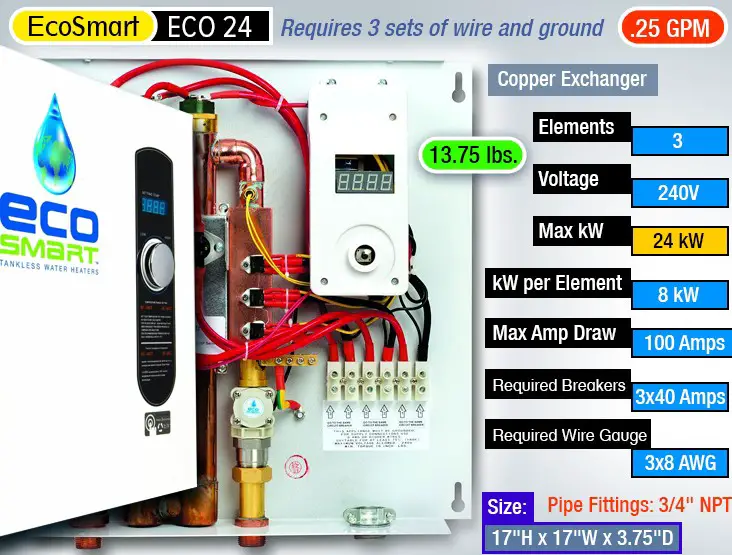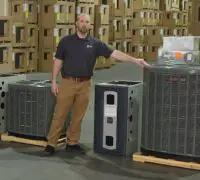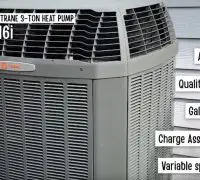If you're looking to fix or replace your Heating or A/C system, we can connect you with a reliable and cost-effective professional in your area.
Tankless water heaters are great since they don’t need a lot of space for storing (only a third of a 10-gallon tank), but mostly for saving you energy and fuel. Since they give hot water on demand, tankless water heaters use less fuel and a lot less water.
No matter the type of unit you choose (gas or electric), tankless water heaters may save you 30%-50%, cutting down your energy bill.
Page Table of Contents
How many amps do tankless water heaters need?
You really have to makes your bits and bobs before choosing between a gas and an electric tankless water heater. Sometimes, a gas model may suit your household better, whereas an electric tankless unit may be the perfect choice for your home.
Since gas-fired units run on gas (propane or natural gas), it’s obvious that the amperage needs differ from the ones of electric units. Keep reading for the details.
How many amps does a gas tankless water heater use?
Should you go with a gas model, you need to consider the venting requirements and to check the current gas line. Some manufacturers provide gas venting “kits,” and you need to get it for proper installation.
As for amperage needs, gas-fired tankless water heaters only need a minimal electrical connection. You should look over the installation requirements for your model when buying.
How many amps do electric tankless water heaters require?
With tankless water heaters only using fuel when you’re tapping the hot water, it makes sense that you will consume less fuel and energy. A standard electric tankless water heater needs at least 120amps to run, and the total capacity for an average home is 200amps.
Should you decide to go with electric tankless water heaters, you must take a look at the following facts:
- Voltage- plenty of brands make units that take 110V, 120V, 208V, 220V, 240V, or 277V
- Amperage- different electric tankless units present different needs in terms of amp draw. Either way, you should always make sure that your household may sustain the electrical demands of your water heater
- Circuit breaker- It’s essential to have a circuit or circuits that handle the electric water heater. At times, you may even have to install the water heater on its circuit or circuits.
It makes sense that you’re going to have to upgrade the electrical system for a more massive load demand, which may quickly get $1,500 out of your wallet.
Let’s also highlight that electric tankless water heaters need particular equipment to be installed at the meter base too. Add $2,000 more to the budget, which makes the electric tankless units look more expensive than the traditional electric water heaters.
In the case of electric tankless water heaters, the breaker size and wire gauge should comply with the local, state, provincial, and national electrical codes in your region. Sub-panel installation may be necessary for systems, especially if you’re not mounting the unit within the line-of-sight of the primary electrical panel.
Don’t forget about the wiring which has to be strong enough for maintaining the voltage drop of less than 3% under load.
Even if the initial investment looks and is high, don’t forget that the tankless units impress with energy efficiency. Recent models of traditional tank-style water heaters have impressed with the ability, reaching an outstanding 0.94 energy factor. Therefore, the electric tankless water heaters don’t sound that ideal nor performant anymore.
Should your home already include a high number of electrical appliances, the chances are that you will need a more extensive electrical service than you one you have. It doesn’t mean that you shouldn’t buy an electric tankless water heater. You simply need to upgrade the electrical service, not before talking with a certified electrician for a quote.
Can we get an example for a better understanding?
Since there are many models of both gas and electric tankless water heaters to choose from, it’s helpful to give you an idea about what you can find out there.
- A 24kW electric unit that has a 3.3GPM power, and 50-degree temperature rise. The groundwater temperature is 55 degrees, whereas the maximum temperature at 3.3GPM will be 105F degrees.
The manufacturer states that the unit needs at least a 300-amp service. Supply of 240V electricity at 100amps and installation of two 60-amp circuit breakers and two runs of no.6 copper wire are necessary. We should state that the unit won’t be a small load, even on a 300-amp service panel.
- A 36kW unit rated at 4.9GPM, with the same specs: 50-degree rise and an exit water temperature of 105 degrees.
In order to gain the 4.9gallon rating, you need 150-amps of 240-V electricity, three runs of no.6 copper wire, and three 60-amp breakers. For older households, it’s mandatory to make an electrical service upgrade before installing the tankless water heater. Not all upgrades are expensive, but many of them are complicated and take a toll on your wallet.
One last thought
Various models of electric tankless water heaters will have different requirements in terms of amperage. You must check the amperage specs very carefully on an electrical unit before placing the order. As for the gas models, the amperage requirements aren’t as fundamental as in the case of electric units, but you do need to see the venting options. It’s a lot of work in both cases, for sure!
We can definitely connect you with a trusted provider in your area to repair, replace or maintain your heating and A/C systems. Why not let us find a professional for you?






